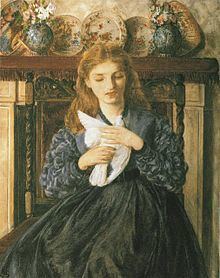Name Rebecca Solomon | Siblings Simeon Solomon | |
 | ||
Died November 20, 1886, London, United Kingdom People also search for Abraham Solomon, Simeon Solomon, Meyer Solomon | ||
Steve benson on the birth of rebecca solomon
Rebecca Solomon (London 26 September 1832 – 20 November 1886 London) was an English painter.
Contents
- Steve benson on the birth of rebecca solomon
- Rebecca solomon and patricia barber
- Biography
- Themes
- References

Rebecca solomon and patricia barber
Biography
Rebecca was one of eight children born into an artistically-inclined Jewish merchant family in Bishopsgate in east London. Her father was Michael (Meyer) Solomon, the first Jew to be honored with the Freedom of the City of London and mother Catherine (Kate) Levy. Rebecca was a sister to her more famous painter brothers Simeon Solomon (1840–1905) and Abraham Solomon (1824–1862). There were five other children in the family: Aaron, Betsy, Isaac, Ellen, and Sylvester.
Initially Rebecca was taught by her older brother Abraham and then took lessons at the Spitalfields School of Design. She exhibited at Royal Academy of Art between 1852 and 1868, and also at the Dudley Gallery and Gambart's French Gallery.
Rebecca worked in the studio of John Everett Millais and the best known example of her work is a version of Millais's Christ in the House of his Parents. She also worked with the second wave Pre-Raphaelite artist, Edward Burne-Jones. As an artist in her own right, she painted works that often reflected gender and social class differences.
Rebecca was also active in contemporary social reform movements and in 1859 she joined a group of thirty-eight women artists petitioning the Royal Academy of Art to open its schools to women, which led to the first woman, Laura Herford being admitted to the Academy in 1860.
In 1886, Rebecca died aged 54, from injuries sustained after being run over by a hansom cab on the Euston Road in central London.
Themes
Solomon's artistic style was typical of popular 19th-century painting at the time and falls under the category of genre painting. She used her visual images to critique ethnic, gender and class prejudice in Victorian England. When Rebecca started painting genre scenes, her work demonstrated an observant eye for class, ethnic and gender discrimination. One critic commented on the wholesome, moral and sometimes humanizing sentiment in her art, not an uncommon element in Victorian painting. However, Rebecca’s Jewish background was probably instrumental in developing her critical consciousness of difference and prejudice. Over the next ten to fifteen years, her artwork explored the plight of women and minorities, and the dominance of class discrimination in English society.
In the late 1850s Rebecca made a successful transition to classical and historical painting, the most highly valued art within the powerful art academies at the time. True to her vision, she continued to include images that reflected the historical foundations of nineteenth-century social injustice.
